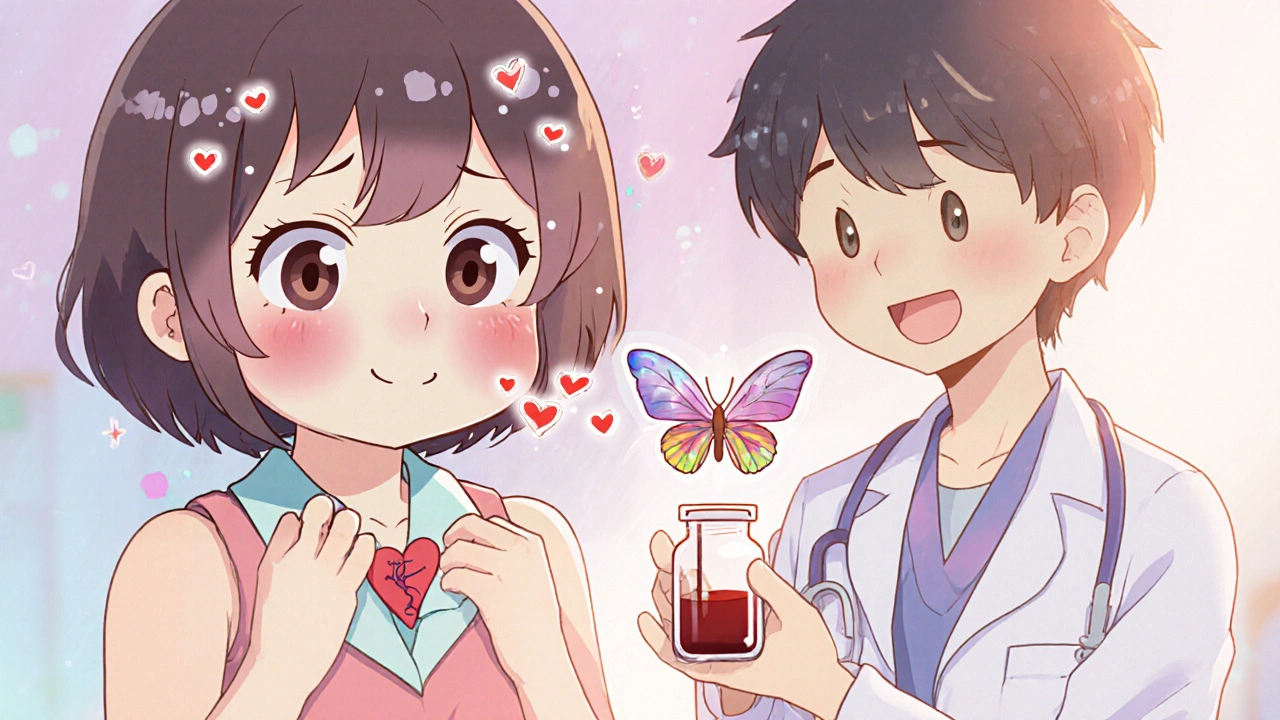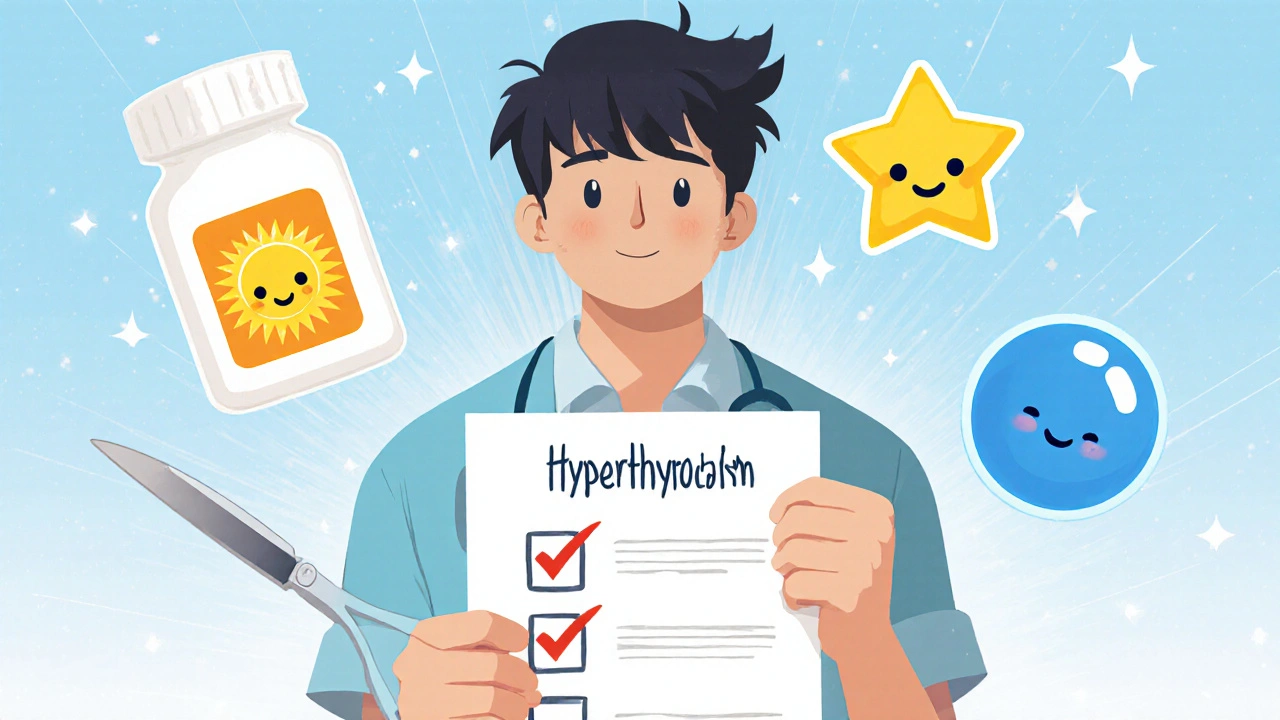Hyperthyroidism Diagnostic Calculator
Thyroid Test Results
Results
Normal ranges:
- TSH: 0.4 - 4.0 mIU/L
- T4: 5.0 - 12.0 µg/dL
This tool is for educational purposes only. It should not be used as a medical diagnostic tool. Please consult your healthcare provider for proper diagnosis and treatment.
When your thyroid runs on overdrive, Hyperthyroidism is a condition where the thyroid gland produces too much of the hormones T3 and T4 can throw your whole metabolism off balance. In this guide we break down why it happens, what to look for, and how doctors pin it down, so you can move from confusion to confidence.
What Exactly Is Hyperthyroidism?
Hyperthyroidism means the thyroid - a butterfly‑shaped organ at the base of your neck - is cranking out excess thyroid hormones. Those hormones, triiodothyronine (T3) and thyroxine (T4), speed up nearly every cell in your body. The result? Faster heart beat, heat intolerance, weight loss, and a whole host of other signs that your internal engine is revved too high.
The thyroid itself is a Thyroid gland an endocrine organ that regulates metabolism by releasing T3 and T4. Think of it as the body’s thermostat for energy use.
Root Causes Explained
Most cases trace back to three big groups. Understanding the source helps doctors choose the right test and treatment.
| Cause | How It Triggers Hormone Overproduction | Typical Lab Pattern |
|---|---|---|
| Graves' disease | Autoimmune antibodies (TSI) stimulate the thyroid to release more hormones | Low TSH, high T3/T4, positive TSI |
| Toxic nodular goiter | One or more thyroid nodules become autonomous, working without TSH control | Low TSH, high T3/T4, normal antibodies |
| Excess iodine intake | Too much iodine fuels hormone synthesis, overwhelming normal regulation | Low TSH, high T3/T4, variable iodine levels |
Graves' disease is an autoimmune disorder where antibodies mimic TSH and over‑stimulate the thyroid accounts for roughly 60‑80% of cases in the U.S. The antibodies, called thyroid‑stimulating immunoglobulins (TSI), bind to the TSH receptor and keep the gland in “always‑on” mode.
In a toxic nodular goiter also known as toxic multinodular goiter, the thyroid develops one or more autonomous nodules that produce hormones independently of TSH, the problem is usually sporadic and appears later in life. Iodine excess, often from supplements or contrast dyes, can tip the balance in susceptible individuals.
Spotting the Symptoms
The classic picture includes a fast heartbeat, shaky hands, and heat intolerance, but many people experience just a few clues. Here’s a quick rundown of what to watch for:
- Rapid or irregular pulse (often >100 beats per minute)
- Weight loss despite normal or increased appetite
- Feeling hot, sweating more than usual
- Tremor of the hands or fingers
- Increased bowel movements or diarrhea
- Sleep disturbances - insomnia or light sleep
- Eye changes: bulging eyes or gritty sensation (typical of Graves' ophthalmopathy)
- Muscle weakness, especially in the upper arms and thighs
- Menstrual irregularities in women
Symptoms can develop slowly over months, so they’re easy to miss or attribute to stress. If you notice a cluster, especially a fast pulse plus weight loss, it’s worth a check‑up.

How Doctors Diagnose Hyperthyroidism
Diagnosis starts with a blood draw to assess hormone levels and the pituitary signal. The key players are:
- TSH (thyroid‑stimulating hormone) - low or suppressed in hyperthyroidism because the pituitary senses excess hormone.
- T3 (triiodothyronine) and T4 (thyroxine) - usually elevated; sometimes T3 is high while T4 is normal, a pattern called T3 toxicosis.
- TSI or thyroid‑stimulating immunoglobulin - positive in Graves' disease.
Imaging and functional tests add detail:
- Radioactive iodine uptake (RAIU) test measures how much iodine the thyroid absorbs, helping differentiate Graves' disease from nodular goiter. A high uptake points to Graves', while a patchy or low uptake suggests nodular disease.
- Thyroid ultrasound - visualizes nodules, cysts, or inflammation.
- Thyroid scan - shows hot (overactive) vs. cold (inactive) nodules.
Putting lab values together with imaging lets the clinician confirm the cause and severity, which drives treatment choice.
Treatment Options Overview
Four main pathways exist, each with pros and cons. The right fit depends on age, severity, pregnancy plans, and personal preferences.
- Antithyroid medications (e.g., methimazole, propylthiouracil) - block hormone synthesis. They’re often first‑line for mild disease or before definitive therapy.
- Radioactive iodine (RAI) therapy - a single oral dose of I‑131 destroys overactive thyroid cells. It’s curative for most adults but can lead to hypothyroidism later, requiring lifelong levothyroxine.
- Surgical removal (thyroidectomy) - partial or total removal of the gland. Chosen for large goiters, suspicion of cancer, or when rapid control is needed.
- Beta‑blockers (e.g., propranolol) - don’t fix hormone levels but quickly tame heart‑rate spikes, tremor, and anxiety while other treatments take effect.
Patients with Graves' ophthalmopathy may need steroids or newer biologics to manage eye symptoms, because the autoimmune process can affect the muscles and tissue behind the eyes.

Living With Hyperthyroidism
Beyond medication, everyday habits help keep symptoms in check:
- Monitor your heart rate; aim for below 100 bpm at rest.
- Stay hydrated and avoid excess caffeine, which can worsen tremor.
- Eat a balanced diet with adequate calcium and vitamin D - thyroid overactivity can lead to bone loss.
- Schedule regular blood tests every 4‑6 weeks during medication adjustments, then every 6‑12 months once stable.
- Discuss any pregnancy plans early; some antithyroid drugs are safer in the first trimester.
Most people regain a normal quality of life after treatment. If you’re newly diagnosed, give yourself time to learn the labs, the meds, and the lifestyle tweaks - the journey gets easier the more you know.
Quick Checklist for Patients
- Get baseline TSH, free T3, free T4, and TSI levels.
- Ask about a radioactive iodine uptake test if the cause isn’t clear.
- Discuss medication options: methimazole vs. PTU, and note any pregnancy considerations.
- Consider beta‑blocker for immediate symptom relief.
- Plan follow‑up labs: every 4‑6 weeks until stable, then semi‑annual.
- Track symptoms daily - pulse, weight, temperature tolerance, eye changes.
- Review bone health with your doctor, especially if treatment extends beyond a year.
What is the difference between hyperthyroidism and Graves' disease?
Hyperthyroidism describes the state of excess thyroid hormones, while Graves' disease is a specific autoimmune cause of that state. All Graves' patients have hyperthyroidism, but not all hyperthyroid patients have Graves'.
Can hyperthyroidism cause weight gain?
Usually it leads to weight loss despite increased appetite. However, if treatment overshoots and you become hypothyroid, weight gain can follow.
Is radioactive iodine safe for children?
RAI is generally avoided in children because their growing bodies are more sensitive to radiation. Surgery or antithyroid drugs are preferred alternatives.
How fast do symptoms improve after starting treatment?
Beta‑blockers can calm heart‑rate and tremor within days. Antithyroid meds may take weeks to normalize hormone levels, while RAI or surgery may need months for full effect.
Can diet alone cure hyperthyroidism?
Diet can support treatment but cannot replace medical therapy. Reducing excess iodine and ensuring adequate nutrients helps, but hormones must be controlled medically.

 Oct, 21 2025
Oct, 21 2025

Erika Thonn
October 21, 2025 AT 17:52Thyroid overdrives like a faulty engine, and you feel the heat.
Brandy Eichberger
October 25, 2025 AT 12:19Ah, dear readers, if you’ve ever felt your pulse pirouette like a jittery ballerina, thank hyperthyroidism for the show. The cascade of T3 and T4 is nothing short of a molecular fireworks display, dazzling yet disruptive. While the guide artfully dissects Graves’ disease and nodular goiter, remember that nuance is the soul of medicine. It’s not merely about labs; it’s about the symphony of patient experience. So, sip your tea, breathe, and let the knowledge settle like fine vintage.
Chirag Muthoo
October 29, 2025 AT 05:47It is commendable that the article delineates both biochemical markers and imaging modalities with precision. The logical progression from low TSH to elevated T3/T4 is presented succinctly. Such clarity aids clinicians in constructing differential diagnoses without ambiguity. I trust this will serve as a reliable reference for practitioners.
Ashok Kumar
November 2, 2025 AT 00:15Oh sure, because reading a 30‑sentence encyclopedia is exactly how I plan to spend my lunch break. But hey, at least I now know my heart can race faster than my Wi‑Fi. Cheers for the over‑education.
Eryn Wells
November 5, 2025 AT 18:42Hey folks! 🌟 This guide is like a friendly tour through the thyroid maze – clear, welcoming, and totally inclusive. 🎈 It even sprinkles handy check‑lists so you’re never lost in medical jargon. Keep spreading the love and knowledge! 💖
Kathrynne Krause
November 9, 2025 AT 13:10Imagine your thyroid as a mischievous artist, splashing T3 and T4 across the canvas of your metabolism. This article captures that chaotic brilliance with vivid flair, turning dense endocrinology into a vibrant story. The tables are not just data; they’re the palette of possibilities. Dive in, feel the pulse of knowledge, and let your health masterpiece begin! 🌈
Angela Koulouris
November 13, 2025 AT 07:38What a brilliant analogy! Your creative spin adds color to the clinical facts, making the information both memorable and motivating. Keep harnessing that artistic spark to empower others on their health journeys.
Harry Bhullar
November 17, 2025 AT 02:05Alright, let’s unpack this thyroid saga step by step, because hyperthyroidism isn’t just a lab result, it’s a full‑blown lifestyle hijacker. First off, the thyroid’s overproduction of T3 and T4 cranks up your basal metabolic rate like someone turned up the thermostat to summer in the middle of winter. That’s why you start sweating buckets, feeling like you’re stuck in a sauna while everyone else is comfortably chilled. Your heart, bless its little ticker, decides to join the party and beats faster, sometimes so fast it feels like a drum solo at a rock concert. Then there’s the classic weight‑loss mystery – you’re munching on snacks, but the calories vanish like magic, thanks to that hyper‑active metabolism. Tremors? Yeah, your hands get the jittery vibe of a badly tuned guitar, and insomnia sneaks in, making bedtime feel like a distant memory. The guide does a solid job outlining Graves’ disease, toxic nodular goiter, and even the iodine overload scenario, each with its own signature lab fingerprint. Low TSH, high T3/T4, and the presence or absence of TSI really help us pinpoint the culprit without guessing. Imaging like radioactive iodine uptake scans adds another layer, showing us whether the thyroid is acting like an overzealous sponge or just a patchy troublemaker. Treatment options? You’ve got the meds that block hormone synthesis, the RAI that essentially “zaps” the overactive cells, surgery for the stubborn goiters, and beta‑blockers that calm the nervous system while the other therapies kick in. It’s a balancing act – you might start on methimazole, watch those hormone levels tumble down, then decide whether to lock in a permanent fix with RAI. And don’t forget bone health; prolonged hyperthyroidism can steal calcium, so supplementing vitamin D and calcium is a smart move. Follow‑up labs every few weeks at first, then once you’re stable, shift to semi‑annual checks – consistency is key. Lastly, keep an eye on those eye symptoms if Graves’ is the cause; steroids or newer biologics can save you from that dreaded eye bulge. All in all, this guide is a treasure map, and with a bit of patience and a dash of self‑care, you’ll navigate back to a calm, well‑tuned metabolic rhythm.
Dana Yonce
November 20, 2025 AT 20:33I was curious about how fast beta‑blockers work, and the article says within days 🙂. That quick relief can be a game‑changer for those racing hearts. Thanks for the clear rundown!
Lolita Gaela
November 24, 2025 AT 15:01The pathophysiology delineated herein underscores the quintessential role of TSH suppression secondary to dysregulated thyrocyte hyperactivity. Empirical evidence corroborates that radioactive iodine uptake scintigraphy yields a quantifiable metric of thyroidal organification efficiency, thereby discriminating etiological subtypes. Moreover, the therapeutic algorithm integrates antithyroid pharmacodynamics, juxtaposing methimazole’s irreversible inhibition of thyroid peroxidase against propylthiouracil’s hepatic metabolism considerations. In the peri‑operative context, total thyroidectomy mandates meticulous recurrent laryngeal nerve preservation to obviate iatrogenic dysphonia. Post‑ablative surveillance necessitates serial quantification of free T4 and TSH to preempt iatrogenic hypothyroidism. Collectively, this compendium furnishes a multidimensional framework for clinicians navigating hyperthyroid management.
Giusto Madison
November 28, 2025 AT 09:28Alright, that’s a lot of fancy talk, but cut the crap – just give us the bottom line! We need clear steps, not a PhD lecture. Keep it straight, and make sure patients know when to get the RAI or surgery. No more beating around the bush.
erica fenty
December 2, 2025 AT 03:56Great summary; concise, clear, and to the point!!!
Xavier Lusky
December 5, 2025 AT 22:24They don’t tell you how radiations from RAI can affect the environment. Keep your eyes open, trust no one.
Jasmina Redzepovic
December 9, 2025 AT 16:51Patriotic citizens know that our health policies prioritize safety, not the shadowy agendas they whisper about. The scientific consensus confirms RAI’s safety when administered properly, and any suggestion otherwise is pure misinformation. Our nation’s regulatory bodies enforce strict dosage guidelines, ensuring minimal exposure. Anyone spreading fear is undermining national progress. Stay informed, stay proud.